Birds rely on tails for flying. They can control the speed of their flight by opening up or closing their tails.
Some species have exclusively white tails, which may serve additional purposes.
For example, some types of male hummingbirds perform display flights in front of females showing their tails as a means of courtship.
The same hummingbirds only have a white undertail as this is the main area of the tail females see when males hover around them.
The tails of many bird species can be white for males alone, as a result.
Some of the following species only show white tails for males while females may have darker tails.
Others show a combination of white tails both for males and females.
Most of these birds are found in tropical and subtropical forests with a presence in other areas such as savannahs, grassland, and shrubland.
Table of Contents
1. White-Tailed Tropicbird
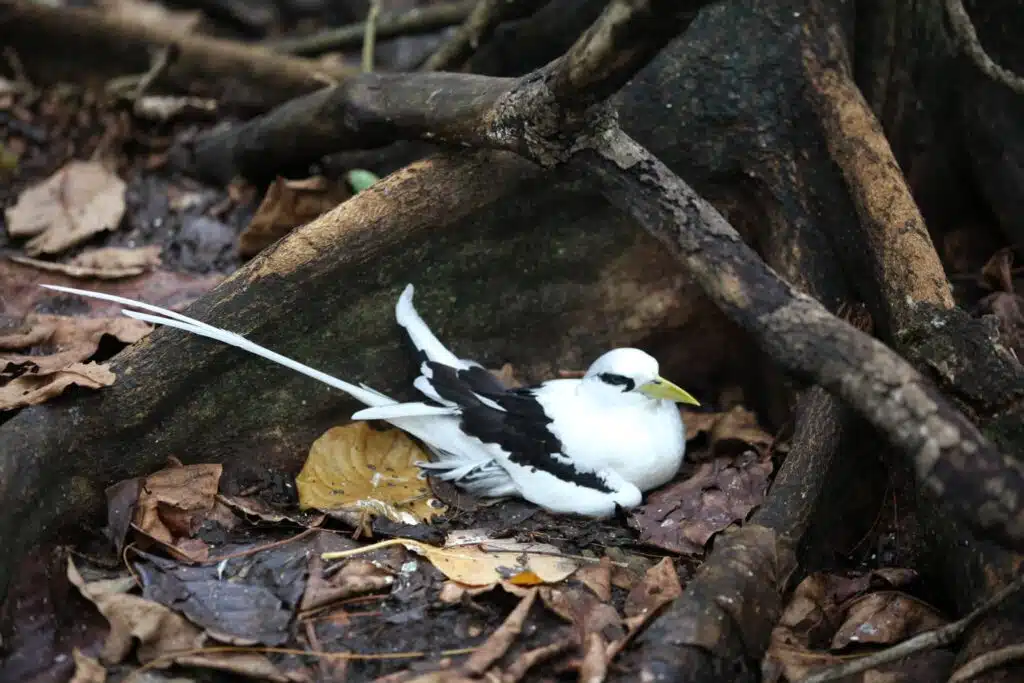
The Atlantic, Pacific, and Indian Oceans are home to The White-Tailed Tropicbird (Phaethon lepturus).
An open-water species, this is a bird with a long white tail compared to the size of its body.
This large bird can measure up to 30 inches in body length and up to 30 inches in tail length as well.
White-tailed Tropicbirds tend to have small sizing differences between males and females. Males are slightly longer with similar longer tails.
This species is specific to tropical islands and remote areas of the world, mainly in the breeding season.
Female White-tailed Tropicbirds can only lay an egg after breeding and they do this in protected remote areas of tropical islands such as on exposed cliffs.
Known for its mostly white plumage, white wings with black tips, and white heads with black stripes along the eyes, The White-tailed Tropicbird species feed on ocean fish.
They catch the fish by flying just above water either alone or in groups as they’re mostly seen in colonies only when breeding.
2. White-Tailed Hawk
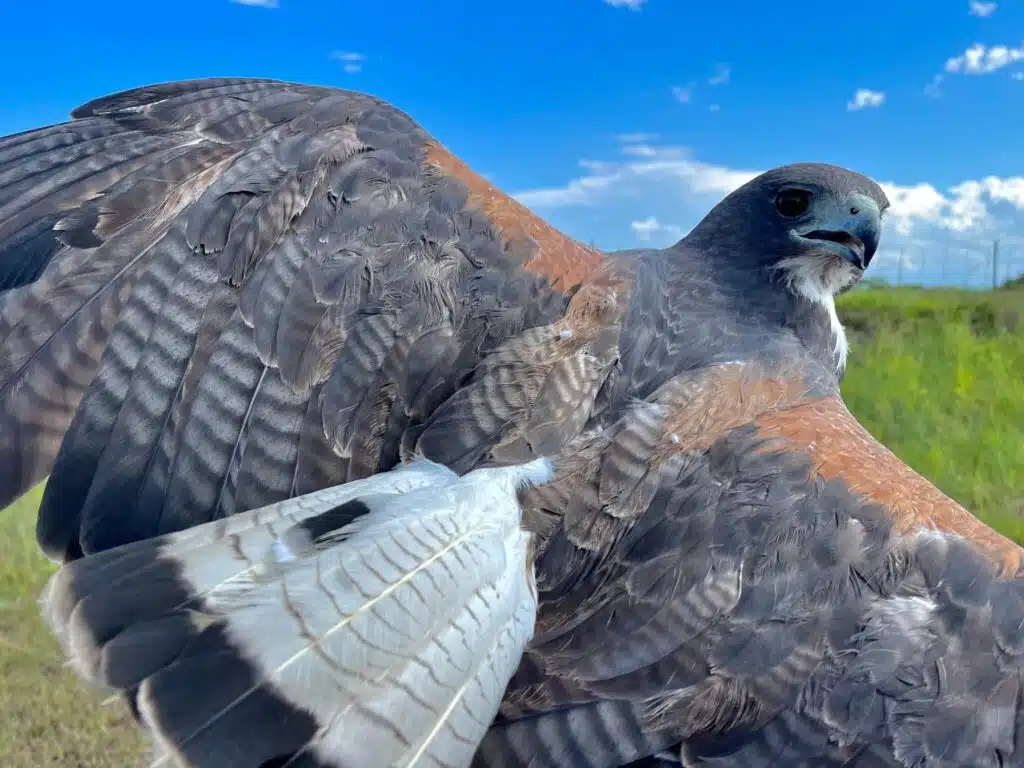
A hawk of the tropics, The White-tailed Hawk (Geranoaetus albicaudatus) is a species endemic to Central and South America.
Its underbelly and its tail are white while its head and wings’ plumage is mostly dark brown.
Found in the warmer climates of The Americas, these hawks also exhibit different traits which allows them to have almost no real predator.
The position of the nest is one of these traits. They build nests high up in trees, preferably on broken twigs where no other birds can land.
These hawks can also nest in other locations, always considerably above the ground.
In urban areas, White-Tailed Hawk nests are spotted on telephone poles where they can also look for food from.
This species is not migratory but it may move territories in periods of low food choices or when its habitat becomes too fragmented.
3. White-Tailed Kite
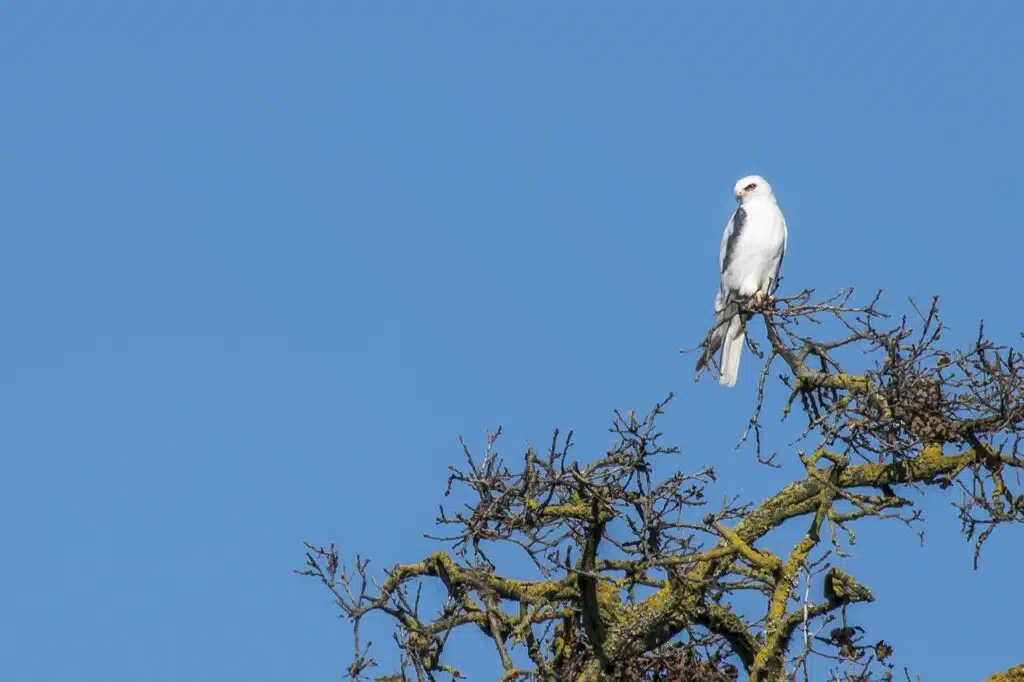
A species that resembles gulls, The White-Tailed Kite (Elanus leucurus) is dominated by gray and white plumages.
Its head and tail are white while most of its wings and the plumage on its underbelly are white.
Kites if the species do have contrasting color irises, which can be red in the case of the male.
Native to Central and South America, this kite species is further known for its elongated tails, which can measure several inches while their bodies grow to at least 14 inches.
An avid predator, The Whtie-Tailed Kite has a diverse diet based on different types of mammals and ground-dwellers.
Rodents, snakes, frogs, and insects are all part of its diet. This wildlife is caught by hovering techniques.
Male kites can become aggressive and territorial towards other males in areas with food.
4. White-Tailed Eagle
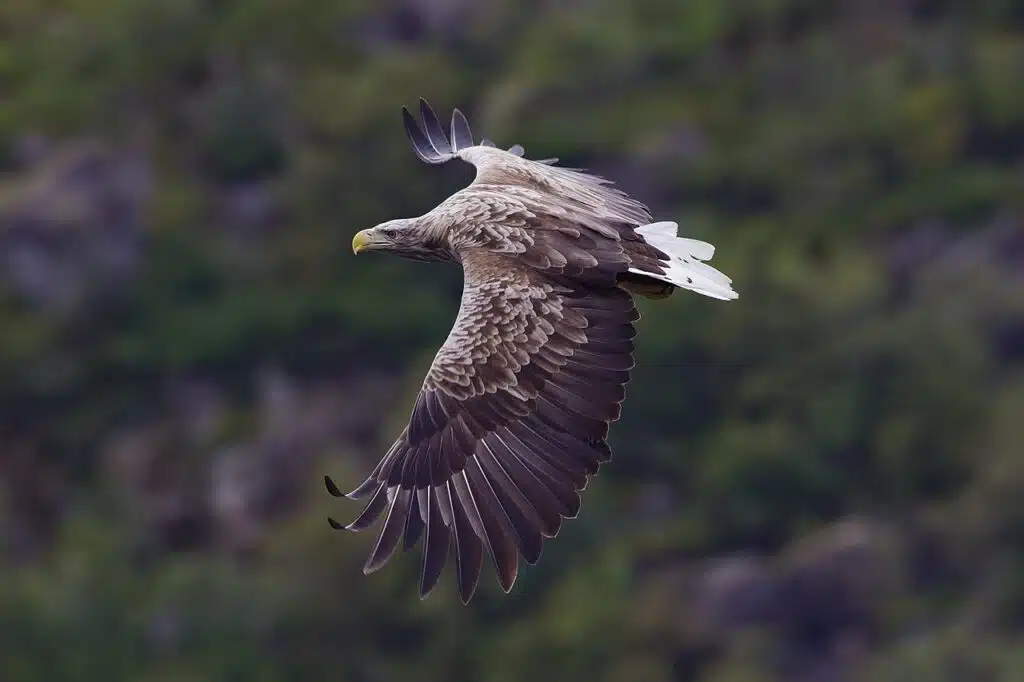
Named after its elongated white tail, this species of eagle (Haliaeetus albicilla) is mostly dark. Its bright tail contrasts its brown and black plumage.
Native to regions of Europe and Asia, The White-Tailed eagle is also one of the most common raptors.
Growing to 37 inches, this raptor is considered skillful and large as its wingspan is often reported as the longest.
A known predator of the woodlands, coastlines, and grasslands, White-Tailed Eagles are opportunistic in their feeding habits.
They can eat different types of fish as well as rodents or any other small mammals.
While these eagles don’t dive, they might do so when going hungry but fish availability means they can grab fish with their feet alone.
A widespread species from Greenland to Japan, this eagle also shows different tail nuances according to its region.
For example, White-Tailed Eagles in the Northern limits of its territory are born with dark tails, which gradually become white.
The age of an eagle can be established by the color of its tail in some cases.
On the other hand, the tail of these Northern eagles is still short, just as those across the rest of its range.
5. Snow Quail
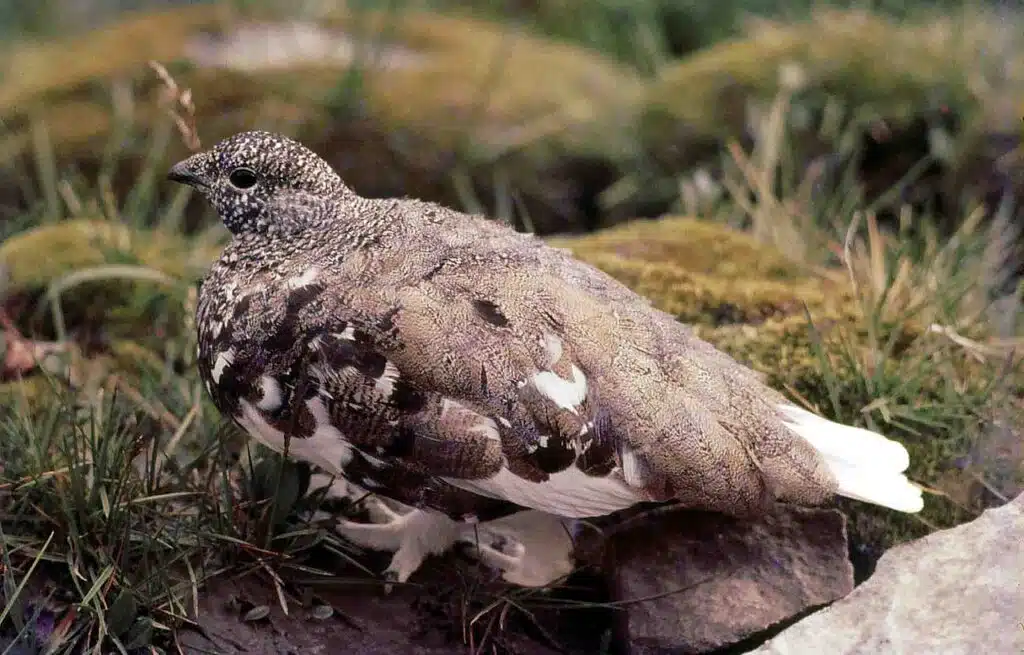
A species of Alaska and Western North America, Snow Quails (Lagopus leucura) are partly white with white tails in the breeding season.
They become entirely white for the wintertime, a period when they rely on their plumage as camouflage.
A species of high elevations, these grouses are found above the tree line.
The natural habitat of the species mostly involves rocky terrains, arid conditions, and short vegetation such as lichens.
This is why their natural plumage even mimics these settings for the warmest parts of the year before becoming fully white.
Lichens are also part of their limited warm-season diet while these grouses turn to other types of vegetation for the winter.
6. White-Tailed Robin
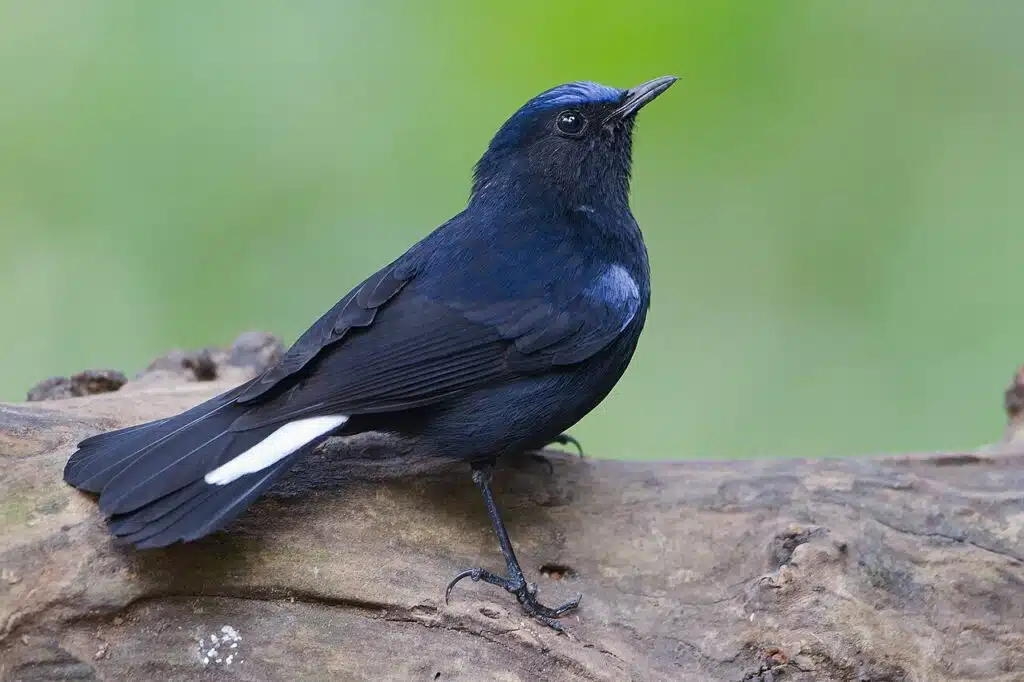
A species found in Northern India, The White-Tailed Robin (Myiomela leucura) is a species named after the white streak along the male’s tail.
This is not a completely white tail but rather a partly white and partly dark blue tail.
As the male is mostly blue, gray, and black, the white section of the tail tends to stand out and inspire the name of the species.
Females don’t look like males and are dominated by faded brown nuances with a dark gray-brown tail.
The short black beak is one of the few physical traits the males and the females of the species share as only the male has 2 white stripes running on the sides of its elongated tail.
7. White-Tailed Trogon
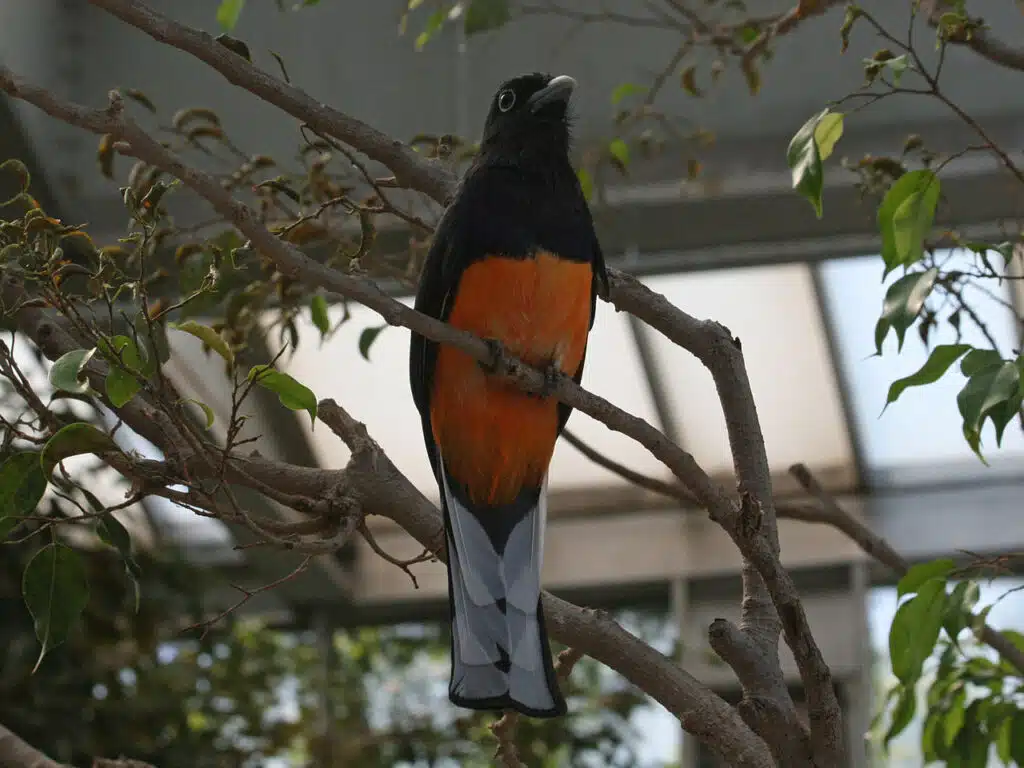
The White-Tailed Trogon (Trogon chionurus) male has a white undertail. Females of the species also show white tails but with black bands.
This is a small to medium-sized species growing to a maximum size of 11 inches with a tail that measures at least 3 inches.
Males have dark blue, black, and orange colors with a dark blue upper tail and a white undertail.
Central and South American habitats are specific to this family of trogons.
The birds are found in different areas such as those of Panama as a Western limit plus Ecuador and parts of Colombia’s tropical forests.
8. Short-Billed Black Cockatoo
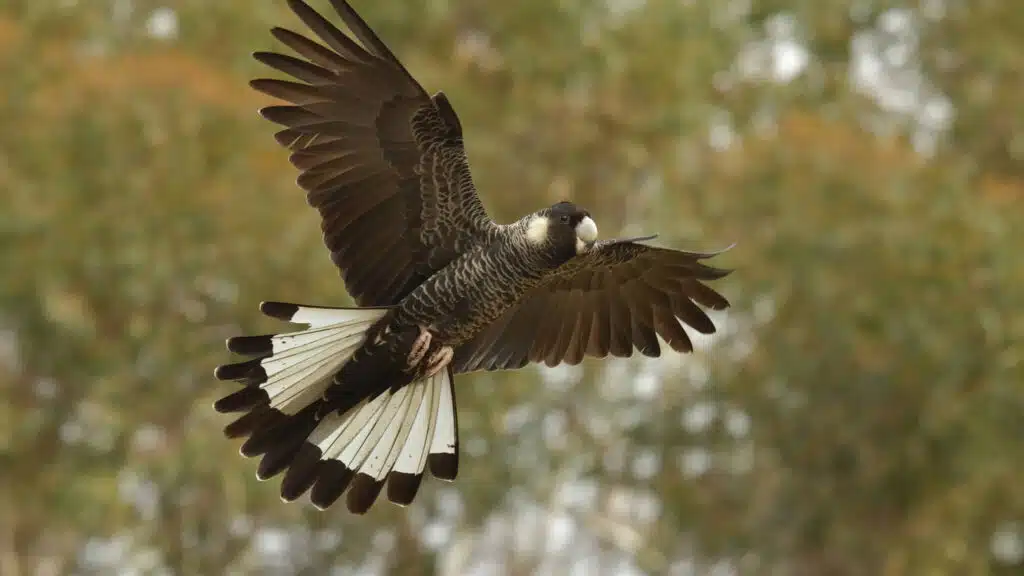
A species of Australia’s Wheatbelt, Short-Billed Black Cockatoos (Zanda latirostris) have partly white tails.
The tails show white streaks and black streaks, especially on the underside. The only other white plumage of the species is the white cheeks or the white circle-shaped patterns on its cheeks.
Males show mostly black plumage while females show mostly gray plumage.
This is a species that feeds on different types of seeds, including eucalyptus seeds.
Its large size and habitat means the Short-Billed Black Cockatoos don’t have too many predators either. With the exception of eagles, they live without a natural predator in Southwestern Australia.
Bushfire, urbanization, and population fragmentation are bigger dangers for the species and are among the main causes of its lesser numbers.
9. Buff-Breasted Paradise-Kingfisher
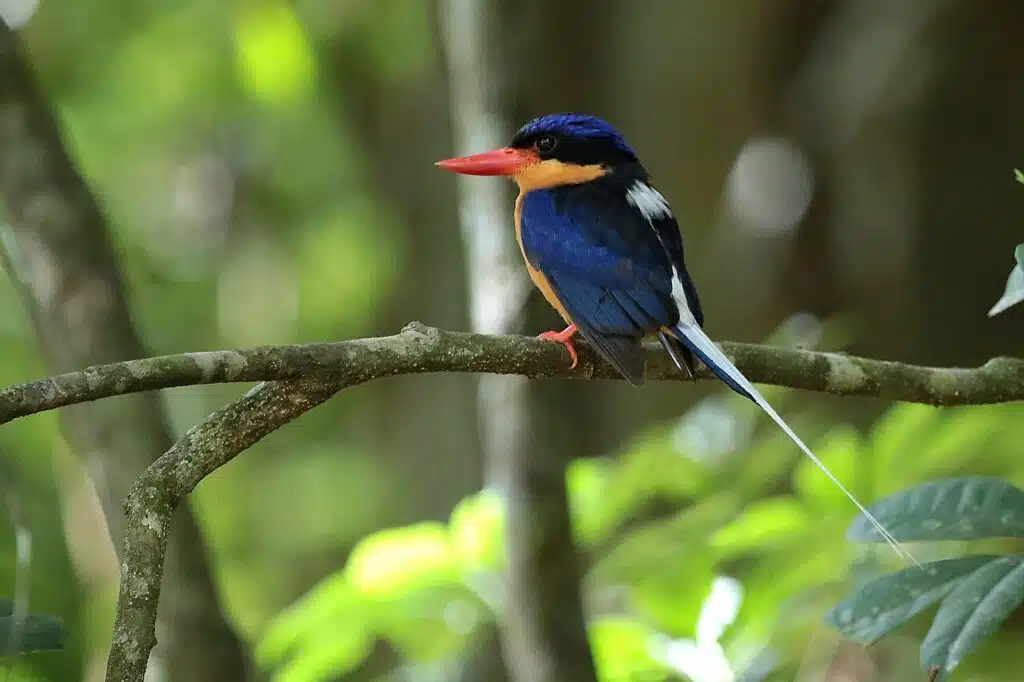
Buff-Breasted Paradise-Kingfishers (Tanysiptera sylvia) have long white tails.
This is one of the most colorful birds with white tails and also a migratory species.
Small birds of this genus live and breed in Australia’s rainforest. The breeding season is specific to the Australian summer.
Birds of the genus then move into New Guinea where they remain before coming back to Australia’s coastline.
Dominated by buff chests and underbellies, these birds are colorful almost appearing yellow in full sun.,
Blue colors are more specific to their dorsal sides and the head cap.
In addition, the long red beaks also stand out on these birds, especially compared to their small size.
10. White-Tailed Jay
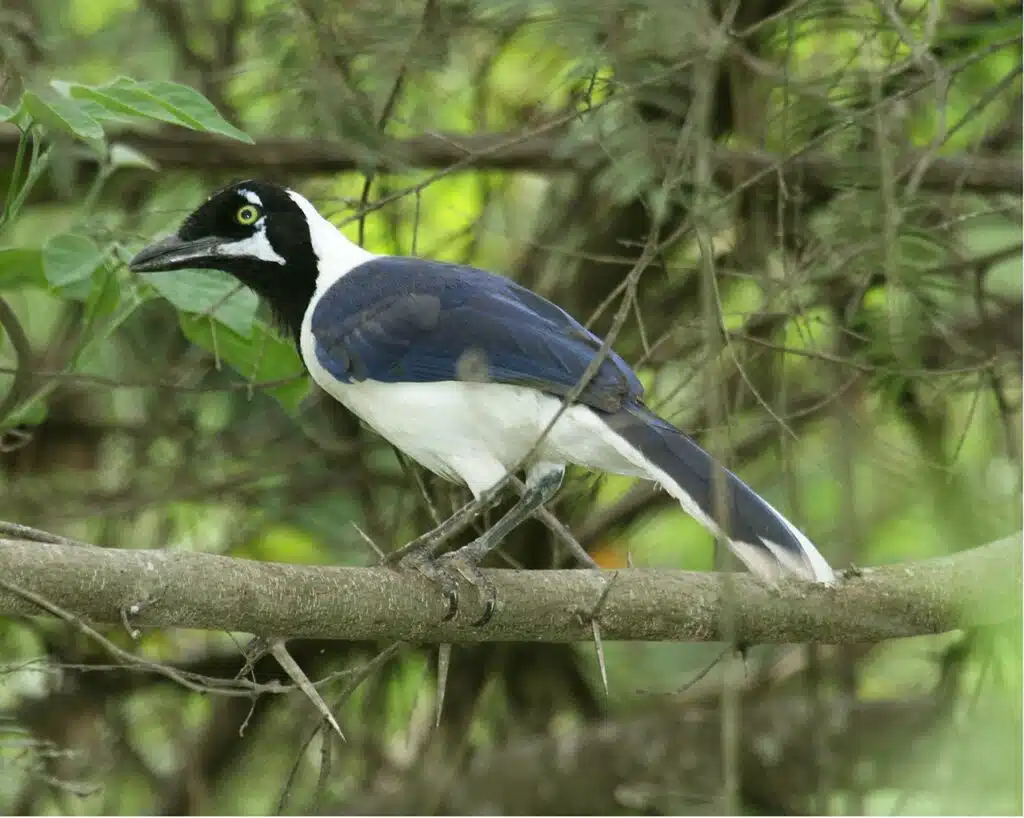
A species of rainforests, White-Tailed Jays (Cyanocorax mystacalis) are a type of corvids, a group of birds that also include crows.
While there are some resemblances between crows and White-Tailed Jays, these birds are mostly white.
They feature white dorsal tail margins and white undertails.
In addition, White-Tailed Jays have a white neck and underbelly while their black heads show white sections on the cheeks and around the eyes.
Black further dominates the coloring of the wings.
Yellow irises are further specific to this tree-dwelling species found in the remote forests of Ecuador and Peru.
11. White-Tailed Starfrontlet
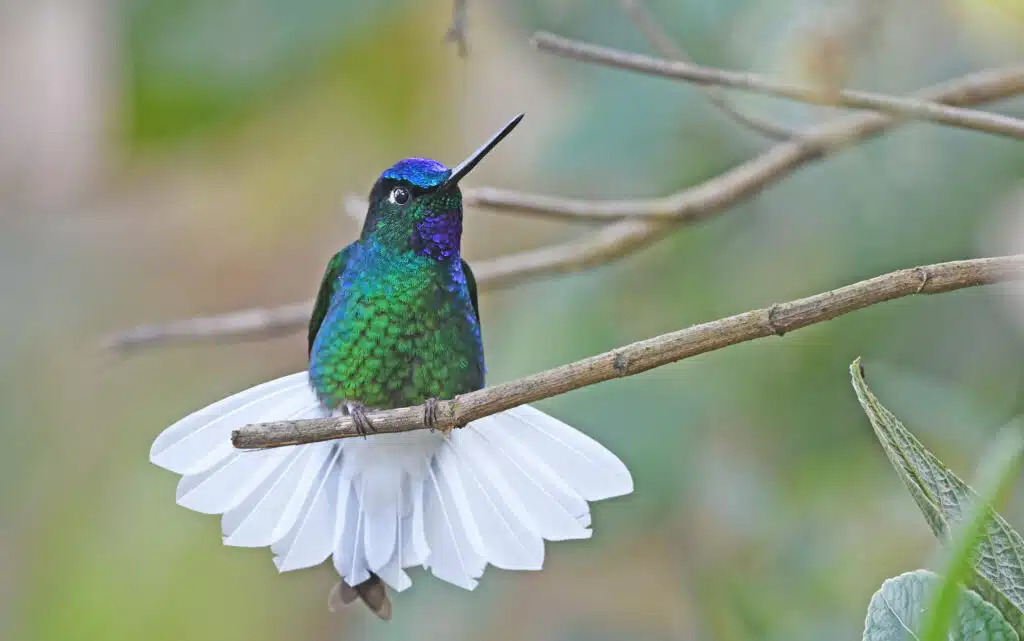
A rare species of Northern Colombia, The White-Tailed Starfrontlet (Coeligena phalerata) is a bird with a white tail.
Pure white is specific to the mid-tail as the species has metallic and dark plumage.
Its head is metallic green with bright green cap coloring during the breeding period. A very long black beak is also specific to these signing birds.
The underbelly is also mostly metallic green while the back of the species has yellow-green iridescence.
Its dark wings also get a purple tint going into the breeding season.
Largely unknown to humans, these birds live in a small mountain range of Colombia even at elevations above 10.000 feet.
12. White-Tailed Shrike
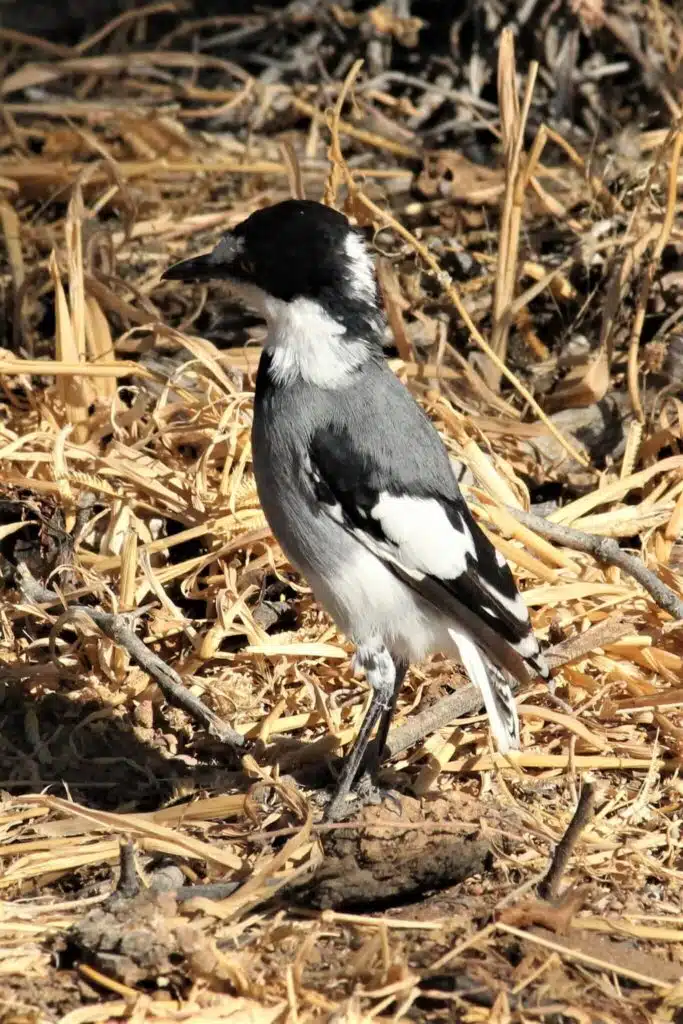
A white undertail and a black and white dorsal tail are specific to The White-Tailed Shrike (Lanioturdus torquatus), one of the smallest types of birds with white tails.
Found in Namibia, the bird is dependent on whatever vegetation it can find in its scrub habitats.
It’s not rare to find the bird (including its nests) on balsam trees in the region.
Thorny plants are an ideal place for it to place its nest for protection.
Apart from its white tail, the species is also identified by its white neck and underbelly. Gray sections are specific to the shoulders while the top of the head is mostly black
This is a bird that gets red eyes when breeding (in the case of the males) and lives in some of the most adverse climates in the world.
13. White-Tailed Crested-Flycatcher
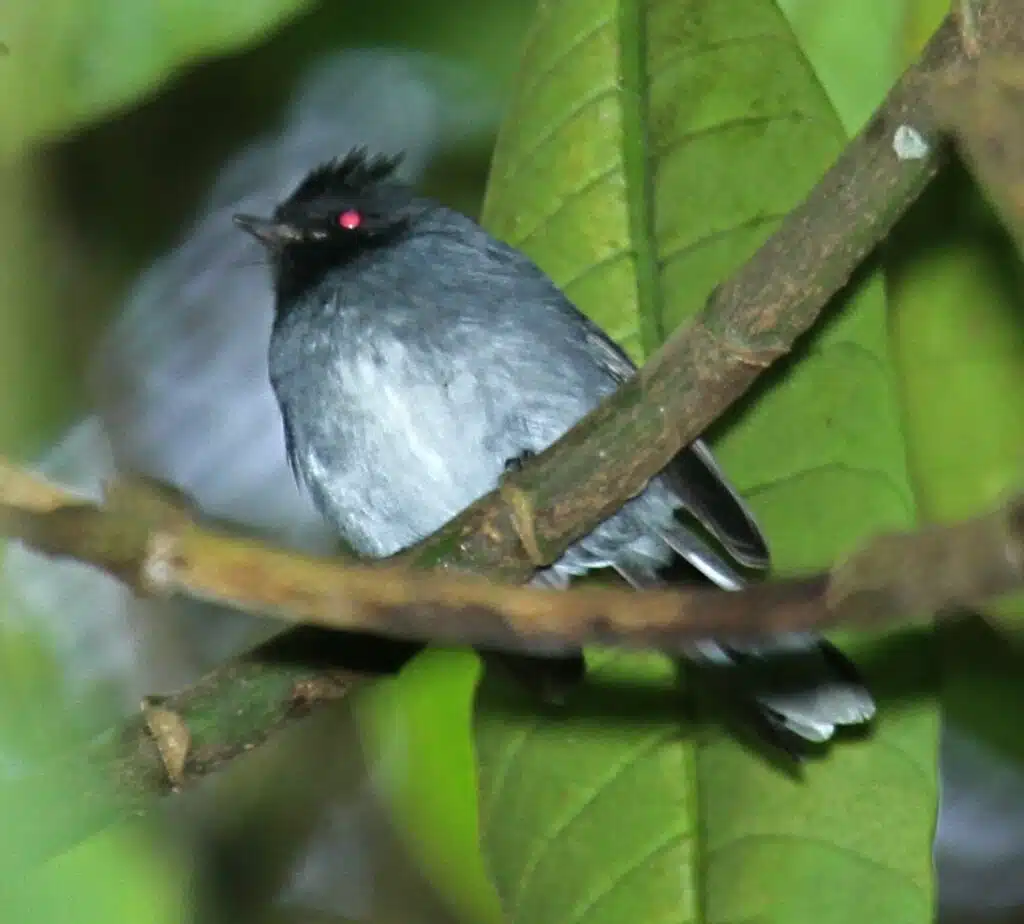
These small birds (Elminia albonotata) are found in the mountains of Tanzania and have white tails.
Most white and gray plumage is specific to the species which additionally shows a black head and red male eyes during the breeding period.
These are some of the lesser-known flycatchers due to their low numbers and remote living.
Like other birds of their type, they feed on insects that they can swoop off the ground or catch in the air.
An African native, The White-tailed Crested-Flycatcher is a species that grows to a size between 4 and 7 inches.
14. White-Tailed Blue Flycatcher
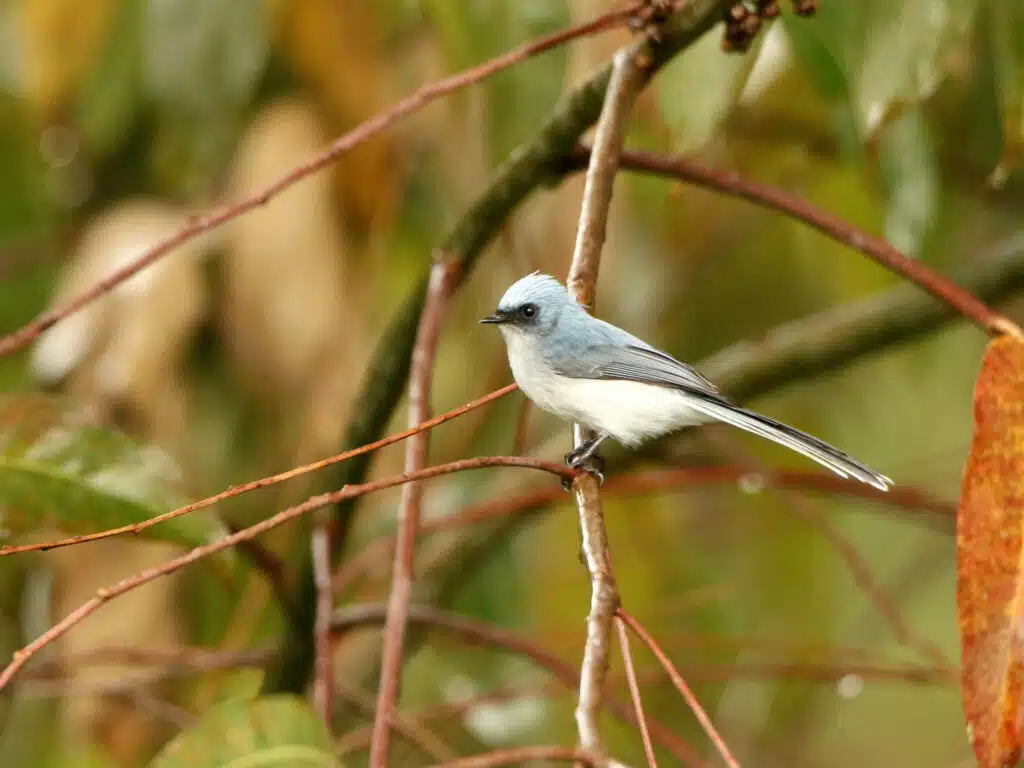
Dey savannahs are the native range of The White-Tailed Blue Flycatcher (Elminia albicauda).
White stripes are seen on the tail of the bird. A bright blue color dominates the appearance of these birds while their underbellies are white.
While blue nuances vary on the species, White-Tailed Blue Flycatchers have long white undertail.
The white section of the tail is best seen when the tail is spread wide open. This is a display males rely on to attract females.
This species of bird feeds on insects such as ants. As other flycatchers, they can mix with other species of flycatchers or other birds of Africa.
A species of the forest, The White-Tailed Blue Flycatcher is also known as The Outer Tail due to the tendency to show the white sections of its tail when its spread out.
15. White-Tailed Emerald
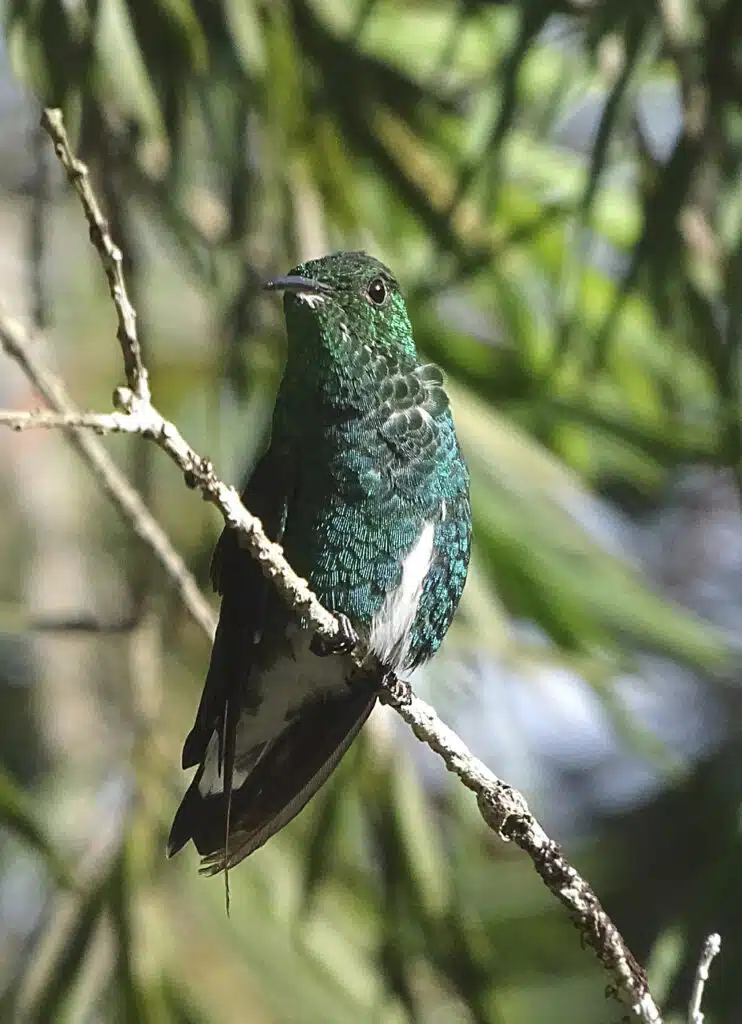
Only found in the forests of Costa Rica and Panama, The White-Tailed Emeralds (Microchera chionura) have dark wings and white tails.
These birds are dominated by iridescent plumage and feature a thin long black beak.
Blue and even purple nuances are specific to these birds going into the breeding season.
White is a tertiary color of the birds, only slightly visible on the dorsal tail but mostly specific to the undertail and the lower part of the belly.
Both males and females show their white tails when flying and when fully open the most.
Birds of this species are arboreal and live at medium and high elevations.
Mostly tied to forests, they can live in the forests or in clearings or edges of the forest.
16. White-Tailed Iora
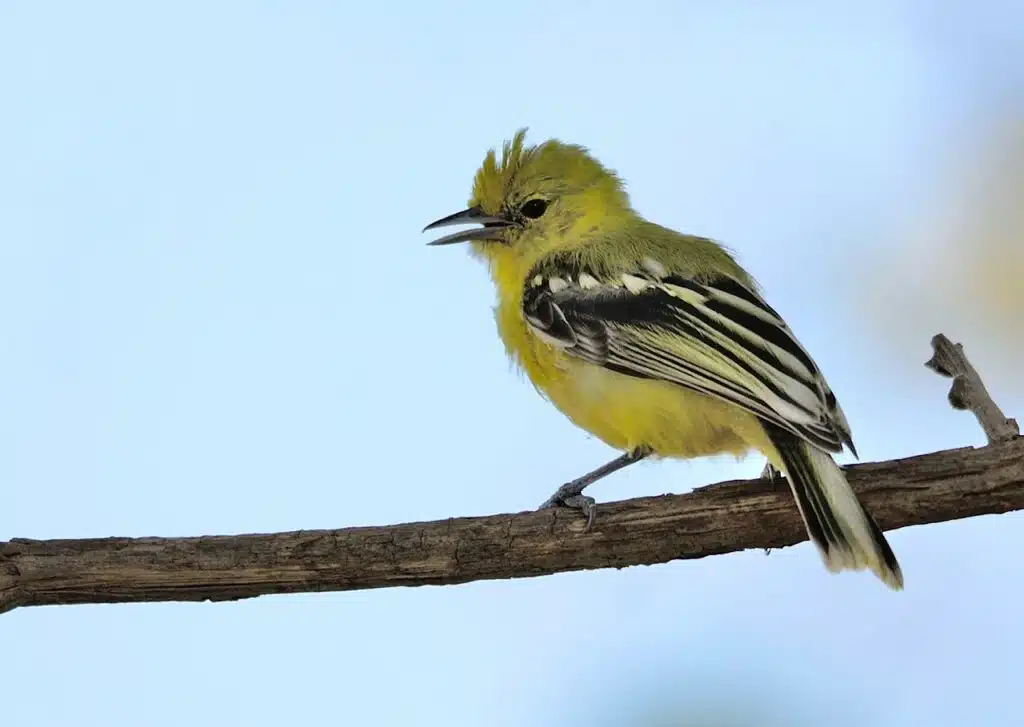
White plays an important role in the appearance of White-Tailed Ioras (Aegithina nigrolutea). These birds have partly white tails.
Additional white stripes on the wings mark the breeding period for males.
Black and white nuances are still specific both to males and females, across tails and wings.
Yellow-green nuances are specific to their underbellies while the males have additional black crests.
Females are mostly yellow-green, smaller, with fewer black and white sections across the wings.
Unlike the black and white wings of males, the wings of the females are only partly black and white as they’re yellow-green at the base.
This species has fragmented populations across India and is not yet fully understood given its reduced presence compared to other Ioras.
17. White-Tailed Sabrewing
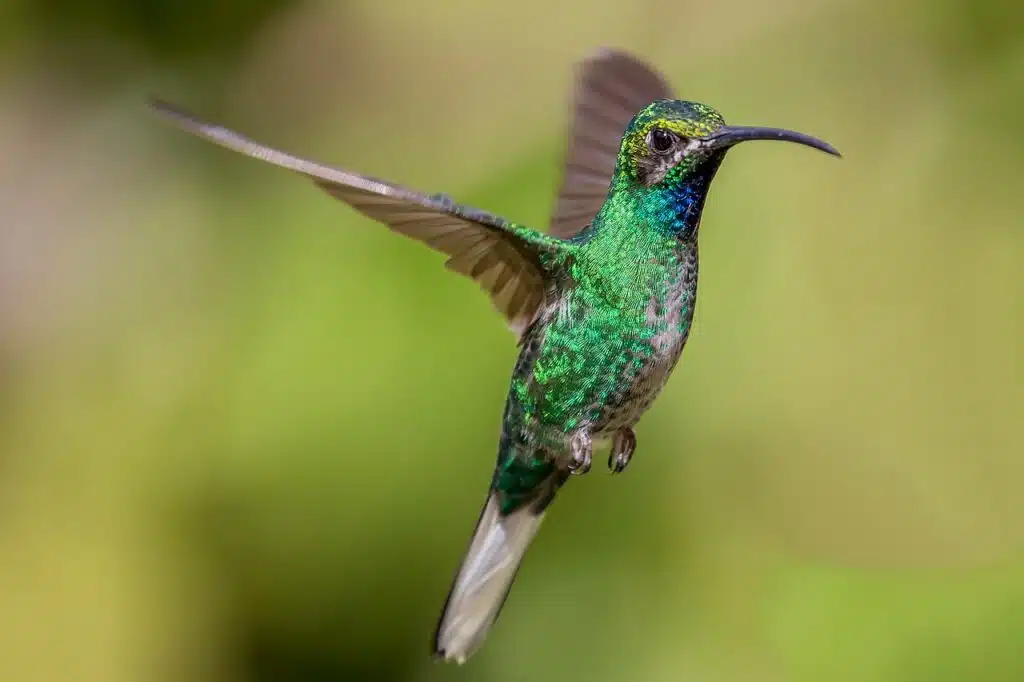
A type of hummingbird, The White-Tailed Sabrewing (Campylopterus ensipennis) is native to Trinidad and Venezuela.
Most birds of the species grow to a size of up to 5 inches and are known by their nectar-feeding habits as well as by their iridescent plumage.
Green iridescence is specific to these hummingbirds which additionally show a white undertail.
Green, dark blue, and black nuances are seen on the birds.
A green dorsum is mostly specific to the birds which additionally show blue necks and chests as well as blue-black wings.
This combination of colors also has a breeding purpose as each male presents itself in front of a female.
The presentation itself is an act of hovering around the female where coloring is believed to be the most important for females choosing a breeding partner.
Sabrewings of this species start breeding from November and males can be identified by their displaying traits as well as by having wider blue sections across the underside.
18. White-Tailed Hummingbird
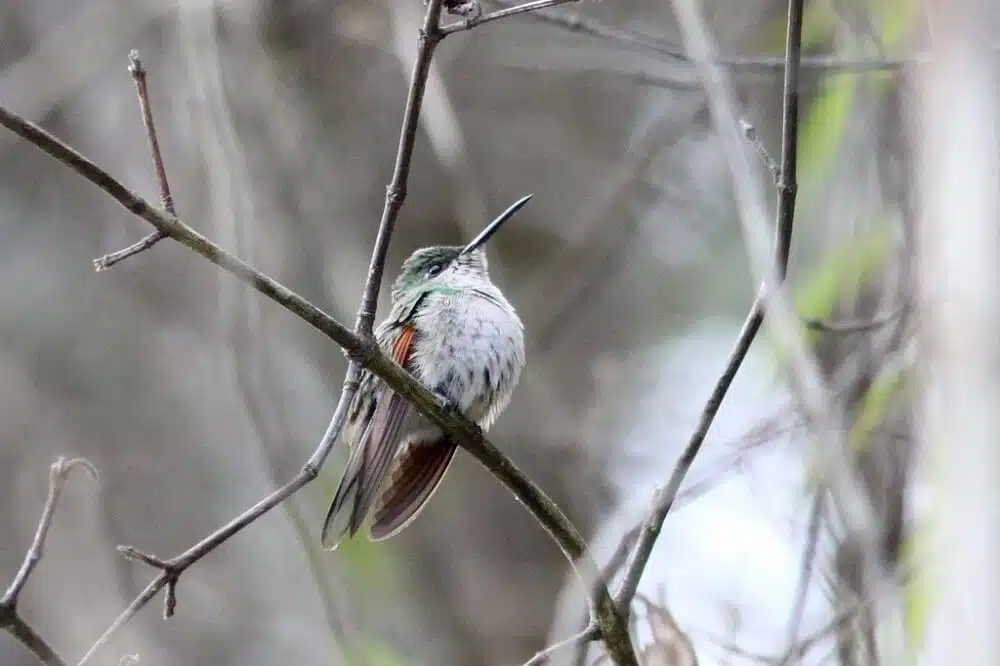
The white tail of the species (Eupherusa poliocerca) is specific to both males and females. Some coloring differences are still seen between the birds.
Males have longer and wider undertail plumage.
The white sections of the undertail continue down to the lower underbelly.
Males display both their white tails and their bronze wings in front of females in the breeding season.
Grene nuances are also dominating the appearance of the male’s dorsum. Females are dull-gray nuances and only show green nuances across the wings.
Bronze-brown wings are specific to males and also show iridescent green sections across the back, head, and neck.
These types of hummingbirds are only found in the humid forests of Mexico. Even here, they inhabit a small area of the Sierra Madre del Sur in Guerrero.
Warmth, humidity, and trees that are always green provide an ideal habitat for hummingbirds.
19. White-Tailed Shrike-Tyrant
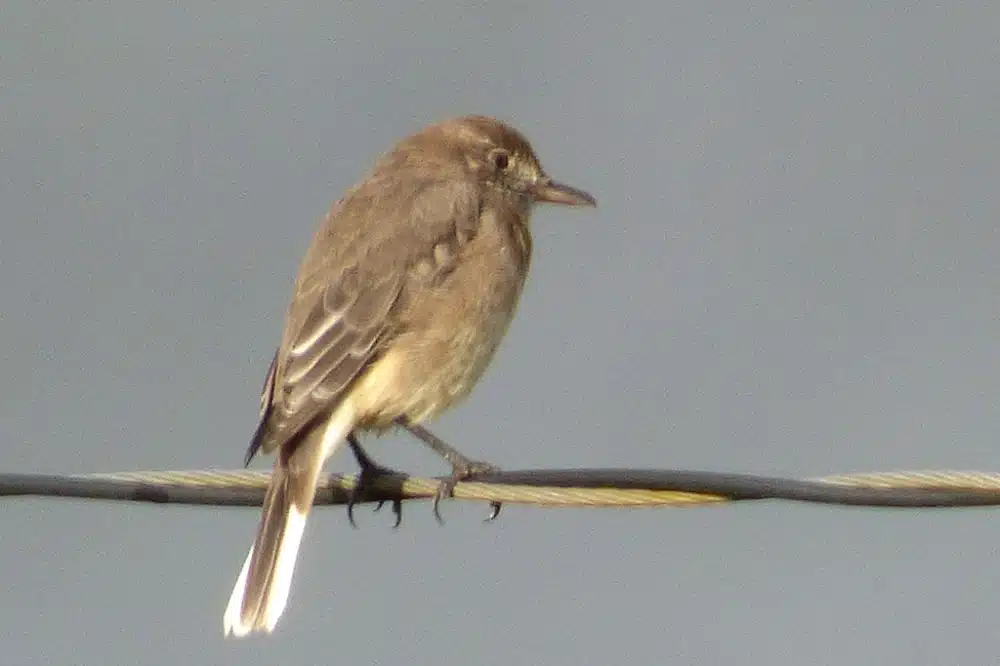
Shrubland and grassland represent the typical habitat of White-Tailed Shrike-Tyrants (Agriornis albicauda). These types of white-tailed birds are native to South America.
From Argentina to Ecuador, the birds are specific to high-altitude habitats of shrubland and can sometimes be spotted on crops as well.
They feature a white-margined tail and a combination of white and chestnut-brown plumage.
Males are darker than females and generally show brown-dominant plumage. Bright females have chestnut, gray, and yellow plumage.
20. White-Tailed Swallow
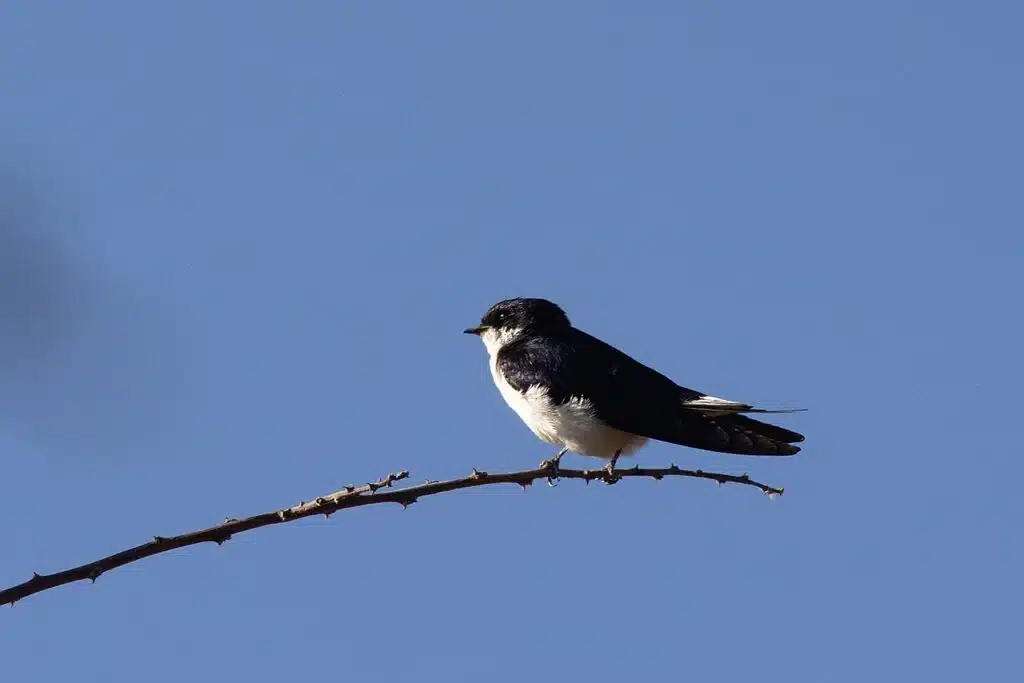
A species with a white underside, The White-Tailed Swallow (Hirundo megaensis) also shows a white undertail.
Blue-black dorsal coloring is specific to the species which shows a dark head, back, and wings.
Native to regions of Africa and high elevations of Ethiopia, this is a species that’s only seen in savannas and grassland above 4.000 feet.
This limited habitat as well as general changes in temperature dictated by climate changes leads to what is believed to be a population of just several thousand White-Tailed Swallows left in the wilderness.
Otherwise, the species benefits from a protected status through its wider area habitat.
Mostly found in The Yabelo Wildlife Sanctuary, this is just one of the species living in this protected area of high elevation.
21. White-Tailed Goldenthroat
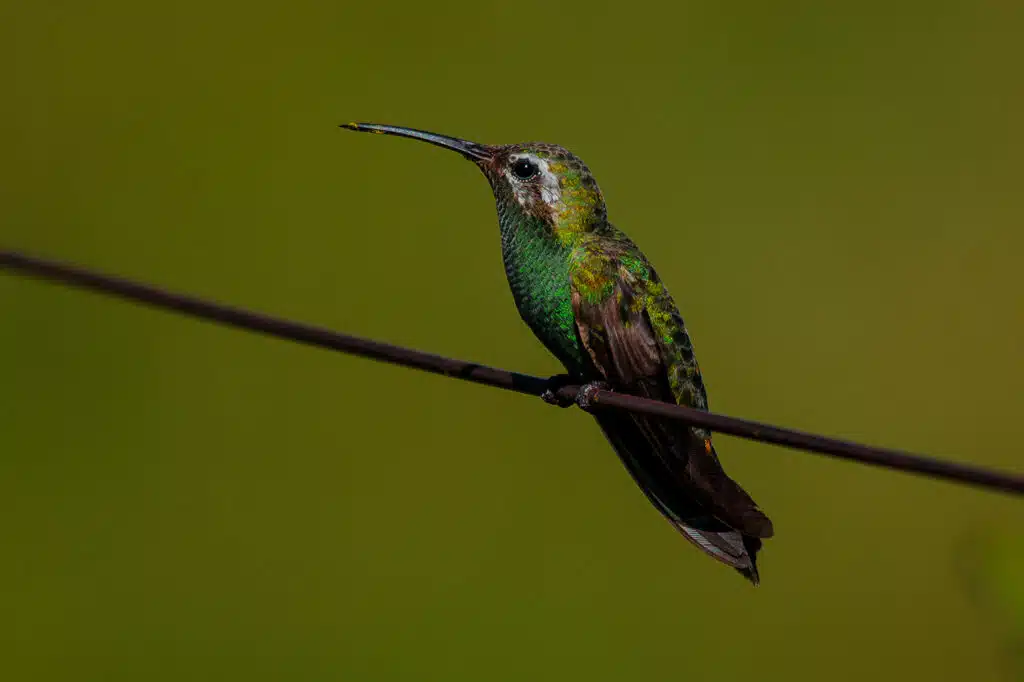
A nectar-feeding species, the White-Tailed Goldenthroat (Polytmus guainumbi) is a species with a white undertail.
Native to South America, this is a species that can also migrate into Brazilian forests during the cooler months.
While its tail is white, the bird is known for its green sheen plumage. Iridescence makes the species stand out in the sun.
Named after the golden-yellow throat colors of males in the breeding season, The White-Tailed Goldenthroat is a species that grows to a maximum size of just over 4 inches.
Some of the best times to spot this bird include the breeding period.
Females build nests that line with vegetation and which are where they lay 1-2 eggs per season.
This is also a time when the birds can be heard singing with their repetitive high-pitched noises.
22. White-Tailed Stonechat
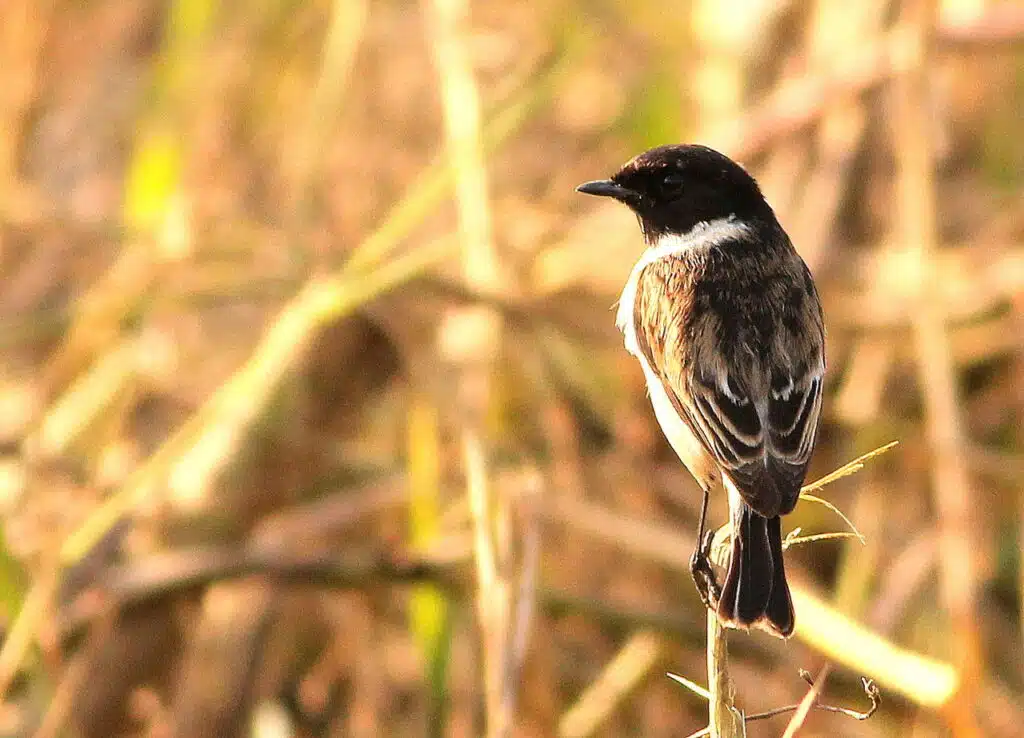
A species of India and Pakistan, The White-Tailed Stonechat (Saxicola leucurus) only lives in high-humidity areas such as around marshes.
They feature a white ventral tail with additional white sections along the sides. There’s also a white collar on a mostly dark brown species.
White dorsal tail sections are seen when the feathers are spread wide open.
The tail is believed to have a distinct role in the species as birds can flick them when flying.
Males undergo small nuance changes or adaptations for the breeding season. They show a red patch on their white chests into the breeding season.
Females are generally similar but brighter than the mostly brown male.
Males have a black head while females have a gray-brown head with similar nuance wings and back plumage.